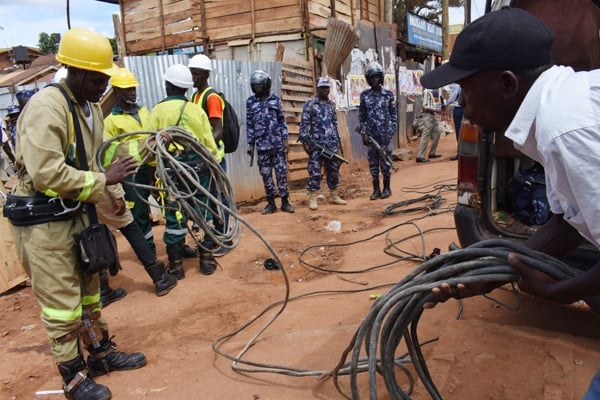Prime
Why Uganda’s grid remains powerless

UETCL engineers disassemble a vandalised tower line inside Kakira Sugar Plantation in Jinja District on October 31. PHOTO/FILE
What you need to know:
Worn down, Uganda’s grid exhibits the dying gasp of an old order. Attempts to have it patched up have been bureaucratically bemired by bouts of corruption in state agencies that are highly episodic in nature.
Parliament’s Committee on National Economy this week gave the green light to a project aimed at increasing access to electricity in the country.
The Electricity Access Scale-Up Project will run under the auspices of the World Bank Group’s International Development Association at a tune of a little over Shs2 trillion.
In a report on the same, the parliamentary committee noted that the loan will help government achieve its medium-term electrification targets captured in the Electricity Connections Policy (ECP) 2018-2027.
With a per capita electricity consumption of 215 kilowatt/hour (kWh) as of 2018, Uganda remains an electricity backwater when juxtaposed with the sub-Saharan (552kWh) and global (2,975kWh) averages. In an October 14 brief to the House, the Finance ministry attributed the unflattering depiction to “high electricity tariffs, high connection costs, high energy losses, limited investments and low power supply quality and reliability.”
The ministry also revealed in the aforesaid brief that the rapid scale-up of electricity connections will see “at least 1.2 million potential customers … connected to the grid.” This, it added, will ultimately “increase the proportion of the population with access to electricity from 24 percent to 44 percent by 2027.
While one of the ECP’s notable goals is to “increase electricity demand on the main grid by 500MW by 2027”, the country’s high-voltage transmission lines for electricity continue to be beset with considerable threats.
Worn down, Uganda’s grid exhibits the dying gasp of an old order. Attempts to have it patched up have been bureaucratically bemired by bouts of corruption in state agencies that are highly episodic in nature.
Bad look
The optics of power infrastructure theft also continue to be infernal. Three Mondays ago, the police—acting on a tip from an informant inside Tembo Steels Ltd—flagged down a Fuso truck in Iganga Town.
“In the truck, there were a lot of transmission tower materials [such as] 85 angle bars and tower bits,” Mr Lawrence Kimbowa, the Uganda Electricity Transmission Company Limited (UETCL) deputy spokesperson, revealed, adding, “The codes on the angle bars were identified as those for the transmission corridor of Bujagali-Tororo power line.”
This was hardly a novel development. The Bujagali-Kakira-Musita-Mayuge transmission corridor alone is estimated to have lost approximately 550,000kg of tower parts in 2021 alone.
Mr Sindronius Okaasai, the junior Energy minister, a fortnight ago sketched a portrait that showed the scale of the impact of such acts of vandalism. Up to 104MW, he revealed, had been “swept off” the national grid due to vandalism.
The affected lines include the 132KV Owen Falls-Lugogo Transmission Line, which vandals destroyed at a site in Kivuvu Village, and the Owen Falls-Mukono North-Mulago Transmission Line vandalised in Nasuuti Village. Both lines were stripped of crucial parts in Mukono District a fortnight ago.
UETCL said the tampering ultimately led to the collapse of four transmission towers, forcing the government to resort to an expensive 50MW Namanve thermal plant as an emergency standby to provide electricity.
In recent months, vandalism has been on the rise, with UETCL reporting that a tower is damaged each day. A sting operation at Kafu in Masindi District this month netted two suspects in possession of 240 transmission tower steel parts culled from the Karuma-Kawanda transmission line.
The assets targeted by vandals such as those in Kafu include pylons, conductors, including transmission infrastructure parts made of steel, aluminium wires, copper wires, transformers and transformer oils, poles, underground cables and related accessories.
Early this year, the Energy ministry said it was engaging its Trade counterpart to cause a ban on scrap metal trade in the country. Despite Mr Okaasai describing the talks as positive, a source at the Trade ministry told this publication that “banning scrap metal trade cannot be an overnight thing.” Our source added that “a deeper multi-sectoral engagement” will secure a breakthrough; although “petition[ing] Parliament” will expedite things.
“If the market is not closed for those buying them (scrap metal industry), they (sellers) will continue vandalising these infrastructures and stealing them,” Mr James Banabe Isingoma, a former director for Energy Resources at the Energy ministry, told this publication, adding, “[The] government has now to step up the vigilance and close the markets of these dealers … Much as the government cannot put security to guard each of the towers, but patrols can be done. We have a lot of idle soldiers in barracks who are not doing anything.”
Lofty goals
UETCL continues to undertake several projects to add to the national grid’s 1700km of high-voltage transmission lines. Its grid development plan for 2018-2040 projects tells increments of about 13,029.43km of transmission lines, 55 additional substations, and 17,229MVA additional transformation capacity.
Evidently, government intends to make investment in energy and mineral development infrastructure the central plank of a trickle-down growth and development plan. It has taken out loans to prop 17 ongoing projects in the energy and mineral development programmes. This has summarily pushed the country’s public debt stock to the Shs80 trillion mark.
The House Committee on National Economy came to the conclusion that while commercial interests stand to directly benefit, there will be a trickle-down effect of capital accumulation.
“The project will directly benefit households, commercial enterprises, including minerals and mining enterprises, public institutions, and industrial parks with access to energy and clean cooking solutions across the country,” the committee stated in a report this week.
Empirical evidence, however, shows that nothing usually trickles down. The gains of the bottom half are rarely memorable, with a K-shaped recovery taking root. Small wonder, experts say, the vast bulk—if not all—culprits red-flagged for vandalising electricity infrastructure are from the bottom half.
Vandalism is but one of many tangibles afflicting Uganda’s 20th Century grid. Mr Michael Taremwa Kananura—the UETCL acting managing director—told this publication that despite being automated and monitored remotely, the grid has “not yet meshed to allow redundancy (more than two) alternative supply routes.” He added: “UETCL also has a small segment of its infrastructure on wooden poles, which are susceptible to vagaries of weather.”
UETCL also has in its inventory thousands of transmission towers whose lattice works of galvanised steel typically range from 50 to 180 feet in height. Since the vast majority of these structures were built in the 1950s, they could do with the proverbial fresh coat of paint. This won’t come on the cheap. In fact, UETCL put the bill of swapping the faltering lattice steel towers with monopoles at just under Shs40b.




